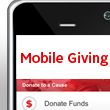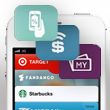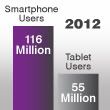By Amy Vale
 Nielsen
Nielsen reported that the average number of apps on a user’s Smartphone jumped from 32 to 41 this year. According to
ABI Research, the total mobile app revenue will explode over the next five years, growing from $8.5 billion to $46 billion in 2016. The remarkable growth of apps has generated a number of different revenue models for publishers. Let’s look at 4 ways publishers can make money from apps.
1. In-App Advertising
A new report from Juniper Research finds that in-app advertising spend across all mobile devices will reach $7.1 billion by 2015, up from $2.4 billion in 2012. While a larger portion of mobile users are moving away from downloading paid apps on their Smartphones initially – even if it’s $1.99 or $2.99 – the opportunity to generate revenue from free-to-download apps isn’t lost. The more downloads and views an app gets, the opportunities for monetization rise exponentially.
Thanks to rich media and an increase in app usage, in-app advertising can significantly improve click-through rates and create an overall engaging experience. To fully capture the attention of mobile users who are multi-taskers by nature with short attention spans, it’s all about making the content entertaining and engaging. So publishers should partner with rich media providers to ensure integrations are seamless for their advertisers’ creative executions to be delivered to mobile users. App users will be far more receptive to see, and act on, ads when they are packaged creatively in rich media formats like expandable banner ads, in-banner video, etc.
2. In-App Purchases
One of the most beneficial aspects of in-app purchases is the additional income stream that can be generated. We frequently see this in gaming apps where additional features and levels can be purchased via “tokens.” In January, mobile app analytics company
Localytics found that 44% of mobile app users did so after their 10
th session in the app. For ‘casual gamers’ who, once downloaded, become loyal ‘super users’ of gaming apps like
Angry Birds and
Words With Friends, paying a nominal fee to keep playing (and winning) seems well worth it.
According to
ABI Research, mobile application revenues from in-app purchases this year will surpass pay-per-download revenues. But, the vast majority of in-app purchase revenue is being generated by a small percentage of devoted mobile game players, and some people are concerned that this revenue source could be fleeting. The question is whether mobile developers, other than game developers, will adopt it?
3. Leverage Demographics of App Users
According to a new study from the
Interactive Advertising Bureau, what devices people are using, when they are using them, and where they happen to be all matter critically to their content preferences, usage patterns and openness to advertising messages. So it goes without saying that publishers should analyze and leverage these insights in determining what ads users of each device see, and don’t see.
Publishers need to leverage the specific demographics associated with each mobile device in order to monetize apps effectively. It is important to remember that each mobile device, and of course each app, is associated with a particular user – age, gender, socioeconomic bracket and more. Leveraging the demographics of the app user will lead to tailored and customized messaging of both the ads and the app itself, and in the end this is a significant factor in the monetization of the app.
The general demographics of an Android user may differ dramatically from the average user that visits your site. For example, knowing that your typical user is a 15 year old could very well be critical in deciding whether to include an in-app purchase via credit card. Understand, leverage and execute those key differences into your broader mobile monetization strategy.
4. Look at the Data and Tweak
Analyzing the data of your app will allow you to become far more sophisticated in future offerings. Look at the campaign components that worked, what didn’t meet expectations, and adjust future plans to maximize your mobile app revenue. Understanding when, where and why CTRs spiked (or fell flat), among other metrics, will set capable publishers apart.
 From all of us at Mocean Mobile, Happy New Year! We hope
the next twelve months bring you clarity about what matters in life (and
business) and strengthen the relationships in your life. Because most of us on
the team are unabashed app lovers and depend on them for just about every type
of activity, I wanted to highlight some apps that are doing things right (and
can offer lessons to developers when building their own apps).
From all of us at Mocean Mobile, Happy New Year! We hope
the next twelve months bring you clarity about what matters in life (and
business) and strengthen the relationships in your life. Because most of us on
the team are unabashed app lovers and depend on them for just about every type
of activity, I wanted to highlight some apps that are doing things right (and
can offer lessons to developers when building their own apps).















 There are over 40,000 health and fitness apps out there, and that number is climbing fast. Not to mention, these healthy apps are expected to bring in $1.3 billion in 2012, according to a
There are over 40,000 health and fitness apps out there, and that number is climbing fast. Not to mention, these healthy apps are expected to bring in $1.3 billion in 2012, according to a 



 Nielsen
Nielsen